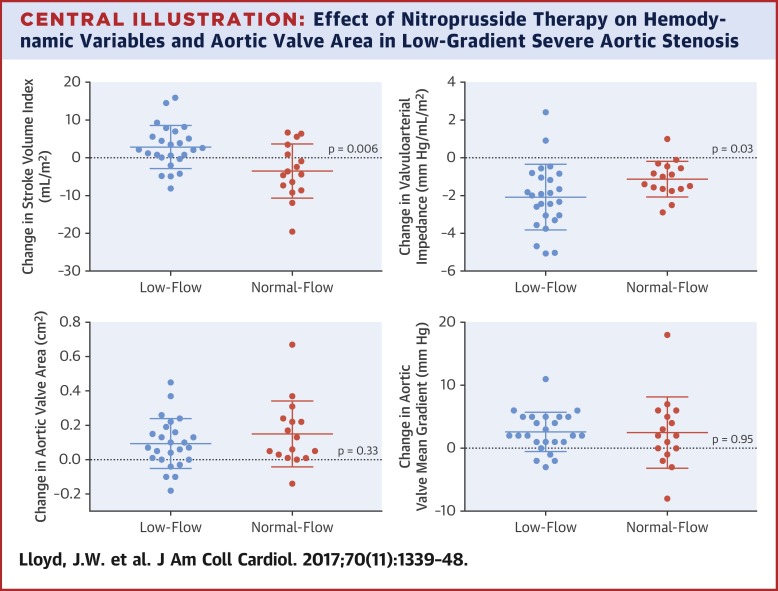当前位置:
X-MOL 学术
›
J. Am. Coll. Cardiol.
›
论文详情
Our official English website, www.x-mol.net, welcomes your
feedback! (Note: you will need to create a separate account there.)
Hemodynamic Response to Nitroprusside in Patients With Low-Gradient Severe Aortic Stenosis and Preserved Ejection Fraction
Journal of the American College of Cardiology ( IF 21.7 ) Pub Date : 2017-09-01 , DOI: 10.1016/j.jacc.2017.07.736 James W. Lloyd , Rick A. Nishimura , Barry A. Borlaug , Mackram F. Eleid
Journal of the American College of Cardiology ( IF 21.7 ) Pub Date : 2017-09-01 , DOI: 10.1016/j.jacc.2017.07.736 James W. Lloyd , Rick A. Nishimura , Barry A. Borlaug , Mackram F. Eleid

|
BACKGROUND
Low-gradient severe aortic stenosis (LGSAS) with preserved ejection fraction (EF) is incompletely understood. The influence of arterial afterload and diastolic dysfunction on the hemodynamic presentation of LGSAS remains unknown. OBJECTIVES
The authors sought to determine the acute hemodynamic response to sodium nitroprusside in LGSAS with preserved EF. METHODS
Symptomatic patients with LGSAS and preserved EF underwent cardiac catheterization with comparison of hemodynamic measurements before and after nitroprusside. RESULTS
Forty-one subjects (25 with low flow [LF], stroke volume index [SVI] ≤35 ml/m2, 16 with normal flow [NF]) were included. At baseline, LF patients had lower total arterial compliance (0.36 ± 0.12 ml/m2/mm Hg vs. 0.48 ± 0.16 ml/m2/mm Hg; p = 0.01) and greater effective arterial elastance (2.77 ± 0.84 mm Hg · m2/ml vs. 1.89 ± 0.82 mm Hg · m2/ml; p = 0.002). In all patients, nitroprusside reduced elastance, left ventricular filling pressures, and pulmonary artery pressures and improved compliance (p < 0.05). Aortic valve area increased to ≥1.0 cm2 in 6 LF (24%) and 4 NF (25%) subjects. Change in SVI with nitroprusside varied inversely to baseline SVI and demonstrated improvement in LF only (3 ± 6 ml/m2; p = 0.02). CONCLUSIONS
Nitroprusside reduces afterload and left ventricular filling pressures in patients with LGSAS and preserved EF, enabling reclassification to moderate stenosis in 25% of patients. An inverse relationship between baseline SVI and change in SVI with afterload reduction was observed, suggesting that heightened sensitivity to afterload is a significant contributor to LF-LGSAS pathophysiology. These data highlight the utility of afterload reduction in the diagnostic assessment of LGSAS.
中文翻译:

低梯度重度主动脉瓣狭窄和射血分数保留患者对硝普钠的血流动力学反应
背景 射血分数 (EF) 保留的低梯度重度主动脉瓣狭窄 (LGSAS) 尚不完全清楚。动脉后负荷和舒张功能障碍对 LGSAS 血流动力学表现的影响仍然未知。目的 作者试图确定 EF 保留的 LGSAS 患者对硝普钠的急性血流动力学反应。方法 有症状的 LGSAS 和保留的 EF 患者接受心导管术,并比较硝普钠前后的血流动力学测量值。结果 包括 41 名受试者(25 名低流量 [LF],每搏输出量指数 [SVI] ≤35 ml/m2,16 名正常流量 [NF])。在基线时,LF 患者的总动脉顺应性较低(0.36 ± 0.12 ml/m2/mm Hg vs. 0.48 ± 0.16 ml/m2/mm Hg;p = 0.01)和更大的有效动脉弹性(2.77 ± 0.84 mm Hg·m2/毫升对比 1.89 ± 0.82 毫米汞柱·平方米/毫升;p = 0.002)。在所有患者中,硝普钠都降低了弹性、左心室充盈压和肺动脉压,并改善了顺应性(p < 0.05)。6 名 LF (24%) 和 4 名 NF (25%) 受试者的主动脉瓣面积增加至 ≥ 1.0 cm2。硝普钠的 SVI 变化与基线 SVI 成反比,仅显示 LF 改善(3 ± 6 ml/m2;p = 0.02)。结论硝普钠降低了 LGSAS 和保留 EF 患者的后负荷和左心室充盈压,使 25% 的患者能够重新归类为中度狭窄。观察到基线 SVI 和 SVI 随后负荷减少的变化之间的反比关系,表明对后负荷的敏感性增加是 LF-LGSAS 病理生理学的重要因素。
更新日期:2017-09-01
中文翻译:

低梯度重度主动脉瓣狭窄和射血分数保留患者对硝普钠的血流动力学反应
背景 射血分数 (EF) 保留的低梯度重度主动脉瓣狭窄 (LGSAS) 尚不完全清楚。动脉后负荷和舒张功能障碍对 LGSAS 血流动力学表现的影响仍然未知。目的 作者试图确定 EF 保留的 LGSAS 患者对硝普钠的急性血流动力学反应。方法 有症状的 LGSAS 和保留的 EF 患者接受心导管术,并比较硝普钠前后的血流动力学测量值。结果 包括 41 名受试者(25 名低流量 [LF],每搏输出量指数 [SVI] ≤35 ml/m2,16 名正常流量 [NF])。在基线时,LF 患者的总动脉顺应性较低(0.36 ± 0.12 ml/m2/mm Hg vs. 0.48 ± 0.16 ml/m2/mm Hg;p = 0.01)和更大的有效动脉弹性(2.77 ± 0.84 mm Hg·m2/毫升对比 1.89 ± 0.82 毫米汞柱·平方米/毫升;p = 0.002)。在所有患者中,硝普钠都降低了弹性、左心室充盈压和肺动脉压,并改善了顺应性(p < 0.05)。6 名 LF (24%) 和 4 名 NF (25%) 受试者的主动脉瓣面积增加至 ≥ 1.0 cm2。硝普钠的 SVI 变化与基线 SVI 成反比,仅显示 LF 改善(3 ± 6 ml/m2;p = 0.02)。结论硝普钠降低了 LGSAS 和保留 EF 患者的后负荷和左心室充盈压,使 25% 的患者能够重新归类为中度狭窄。观察到基线 SVI 和 SVI 随后负荷减少的变化之间的反比关系,表明对后负荷的敏感性增加是 LF-LGSAS 病理生理学的重要因素。











































 京公网安备 11010802027423号
京公网安备 11010802027423号